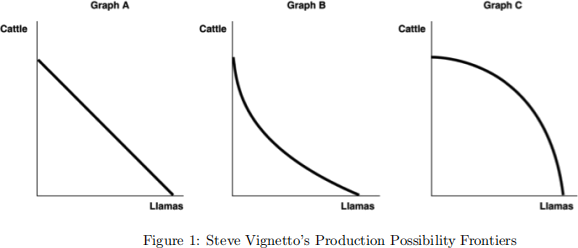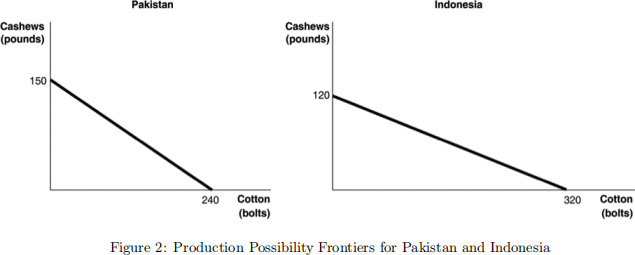ECON7002 Tutorial 2 Semester 2 2023
Hello, dear friend, you can consult us at any time if you have any questions, add WeChat: daixieit
ECON7002 Tutorial 2
Semester 2 2023
Multiple choice Questions
1. As women,s wages have risen relative to men,s wages, the opportunity cost to women of doing housework has than has the opportunity cost to men.
(a) increased less
(b) increased more
(c) decreased more
(d) decreased less
2. which of the following statements is true?
(a) Individuals who have never been the best at doing anything cannot have a comparative ad- vantage in producing any product.
(b) Individuals who have never been the best at doing anything can still have a comparative advantage in producing some product.
(c) Individuals who have never been the best at doing anything perform all tasks at a higher opportunity cost than others.
(d) Individuals who have never been the best at doing anything must have an absolute advantage in at least ones task.

3. Refer to Figure 1 steve vignetto raises cattle and llamas on his land. His land is equally suitable for raising either animal. The graph in Figure 1 that represents his production possibility frontier is .
(a) Graph A
(b) Graph B
(c) Graph C
(d) either Graph B or Graph C
4. Refer to Figure 2 steve vignetto raises cattle and llamas on his land. A portion of his land is more suitable for raising cattle, and the other portion is better suited for raising llamas. which of the graphs in Figure 2 represents his production possibility frontier?
(a) Graph A
(b) Graph B
(c) Graph C
(d) Either Graph B or Graph C
5. For each bottle of wine that Italy produces, it gives up the opportunity to make 10 kilograms of cheese. France can produce one bottle of wine for every 25 kilograms of cheese it produces. which of the following is true?
(a) Italy has the comparative advantage in cheese.
(b) Italy has the comparative advantage in wine.
(c) France has the absolute advantage in wine and cheese.
(d) France has the comparative advantage in wine.

6. Refer to igure 2, what is the opportunity cost of producing 1 bolt of cotton in pakistan?
(a) ![]() of akilogram of cashews
of akilogram of cashews
(b) ![]() of akilogram of cashews
of akilogram of cashews
(c) 1 ![]() kilograms of cashews
kilograms of cashews
(d) 150 kilograms of cashews
7. Refer to igure 2, what is the opportunity cost of producing 1 bolt of cotton in Indonesia?
![]()
![]()
(c) 2 ![]()
(d) 120 kilograms of cashews
8. Refer to igure2, if the two countries have the same amount of resources and the same technological knowledge, which country has an absolute advantage in the production of cotton?
(a) Indonesia
(b) They have the same advantage
(c) pakistan
(d) cannot be determined
9. If the best surgeon in town is also the best at cleaning swimming pools, then according to economic reasoning, this person should .
(a) pursue the activity he enjoys more
(b) specialise in cleaning swimming pools because it is more labour-intensive (c) split his time evenly between being a surgeon and cleaning swimming pools (d) specialise in being a surgeon because its opportunity cost is lower
10. If, in response to an increase in the price of chocolate, the quantity of chocolate demanded decreases, economists would describe this as
(a) a decrease in demand.
(b) a decrease in quantity demanded.
(c) a change in consumer income.
(d) a decrease in consumers, taste for chocolate.
short-Answer/ problem-solving Questions
1. paul and John can each either bake bread or make jam. In each hour, paul can either bake 2 loaves of bread or make 1 jar of Jam. In the same hour, John can either bake 1 loaf of bread or make 4 jars of Jam. paul and John each has 10 hours to work each day.
(a) calculate how much of each good is produced in the following circumstances, which we label A, B, c and D.
(A) Both John and paul spend all their time baking bread.
(B) Both spend all their time making jam.
(c) Both spend half of their time on the production of each good.
(D) paul spend all of his time on baking bread and John spend all of his time making jams. (b) Draw the production possibilities Frontier for John and paul combined,i.e. what combinations
of bread and jam would John and paul be able to produce by working together? Let the vertical axis denote quantity of bread produced and the horizontal axis the quantity of jam. plot points A, B, C and D from part (a) onto this graph. (Hint: First consider the scenario in which John and paul only produce bread. If they want to produce 1 jar of jam, who should switch from baking bread to making jam? what is the opportunity cost of the irst jar of jam?)
(c) which production combination A, B, C or D is/are productively ine伍cient? (d) Complete the following table

(e) who has an absolute advantage in the bread production? who has an absolute advantage in jam production?
(f) who has acomparative advantage in the bread production? who has a comparative advantage in jam production?
(g) In which product would you suggest paul to specialise? why?
2. suppose paul and John are allowed to trade their products with one another.
(a) will paul be willing to trade 1 loaf of bread to John in return for 5 jar of jam? (b) will John be willing to trade 5 jars of jam to paul in return for 1 loaf of bread?
3. what range of “terms of trade”do you think will be acceptable to both individuals? which indi- vidual will sell bread and which individual will buy bread?
4. For each of the following pairs of products, state which are complements, which are substitutes and which are unrelated.
(a) Mashed potatoes and pasta
(b) An Economics course and an Economics Textbook
(c) strawberry Jam and Marmalade
(d) Cars and Aeroplanes
5. when smartphones based on the Android operating system were irst introduced, there were rela- tively few applications, or ‘apps,, available for them. Now, there are many more apps available for Android-based smartphones. Are these apps substitutes or complements for smartphones? How has the increase in the availability of apps for Android-based smartphones afected the demand for
Apple iphones? Explain.
(you might ind this article interesting: https://www.wired.com/2011/04/mf—android/)
2023-08-23